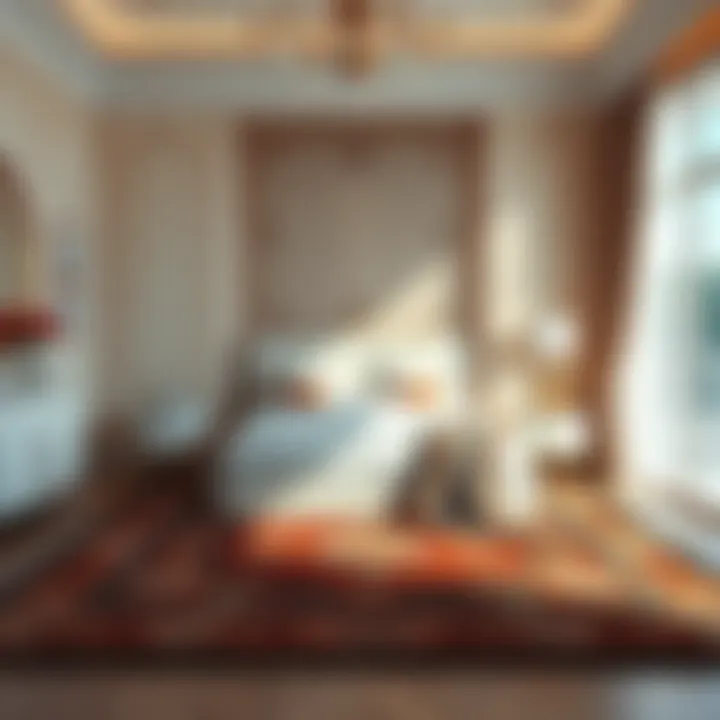The Ultimate Guide to Bedroom Floor Rugs: Style and Comfort


Intro
When it comes to curating a space that truly feels like home, the bedroom stands out as a sanctuary where one can relax and recharge. While paint color and furniture arrangement are often the focal points of decor discussions, the role of bedroom floor rugs is frequently brushed aside. Rugs do not merely serve as functional items but act as artists, painting warmth, texture, and character across the bedroom floor. They have the power to tie a room together, pulling together various elements into a cohesive, inviting retreat.
Floor rugs can greatly affect the overall vibe of a room. They can be your bedrock, both literally and figuratively, giving a foundation of comfort. So, whether you are aiming for a bohemian feel with vibrant patterns or embracing minimalism with subtle hues, choosing the right rug can elevate your bedroom experience significantly.
In this essential guide, we will explore the fascinating world of bedroom floor rugs. From the current trends in styles and colors to practical considerations of material and placement, this guide aims to endow you with knowledge that will help elevate your personal space. By highlighting the inherent beauty and comfort of rugs, we will equip you with insights crucial for making informed decisions to enhance your bedroom decor.
Let’s step into the vibrant world of textiles, and discover how these versatile floor pieces can revolutionize your bedroom.
Understanding Bedroom Floor Rugs
Understanding the role of bedroom floor rugs offers a multifaceted look at how such elements contribute to overall aesthetics and functionality. More than mere accessories, the right rug can serve as a foundation for a room’s style while providing comfort underfoot. For countless homeowners and housewives seeking a personal touch in their sleeping spaces, interior decisions often begin with the choice of rug. This article brings to attention the pivotal aspects of rugs—encompassing their purposes, psychological effects, and considerations for selection.
Defining the Purpose of a Bedroom Rug
When thinking about bedroom floor rugs, it's crucial to first articulate their primary functions. A rug can anchor a space, create warmth, and enhance visual interest—all while improving comfort. Twocore purposes can be identified:
- Aesthetic Harmony: Rugs often influence a room's color palette and overall theme. A well-chosen rug effectively ties various elements in the room together, adding coherence. For instance, a vibrant Persian rug can become a focal point, pulling shades from wall paint or bedding.
- Comfort and Insulation: From a practical standpoint, rugs provide warmth and cushioning, particularly in colder climates. Nothing beats stepping out of bed onto a soft surface that offers both coziness and a sense of security. The tactile experience contributes significantly to how a person perceives their space.
However, it’s essential to consider the size, style, and material of the rug in relation to the bedroom's dimensions and décor. A rug that's too small or poorly placed can disrupt the flow and appear out of context.
The Psychological Impact of Area Rugs
The presence of an area rug can influence not just the room’s ambiance, but also the mental state of its inhabitants. Research highlights various psychological elements associated with such decor:
- Creating Zones: Rugs can delineate different areas within a space, making them feel more organized and functional. A large area rug beneath a bed can signal the cozy sleeping zone, while a smaller rug near a seating area can highlight a reading nook.
- Emotional Well-Being: Colors and textures can elicit various emotional responses. For instance, softer tones may evoke calmness, while bold patterns might energize the room. Choosing the right rug can significantly impact one's mood and general sense of well-being within the home.
"A rug not only beautifies your floor; it can also uplift your spirit and create a sense of belonging in a space."
By understanding these dimensions, homeowners can select rugs that resonate personally and serve functions beyond mere decoration. This guide will delve deeper into the types, materials, and placement techniques for ensuring that every rug fulfills its potential within the sacred space of your bedroom.
Types of Bedroom Rugs
When selecting a bedroom rug, one has to think about the diverse styles available. Different types of rugs offer unique aesthetics, textures, and benefits. They allow for personal expression while ensuring comfort underfoot. Choosing the right rug can elevate the overall vibe of a space, making it feel warm and inviting. Moreover, understanding the various styles helps in matching them with existing decor. Let's dive into some noteworthy types of bedroom rugs that can resonate with every taste and requirement.
Persian and Oriental Rugs
Persian and Oriental rugs stand as timeless masterpieces in the world of textiles. Their intricate designs and vibrant colors bring a cultural richness to any bedroom. Each motif tells a story; some reflect the artisan's heritage, while others symbolize prosperity or protection. Choosing a Persian rug can serve as both a style statement and a conversation starter within your home.
These rugs are crafted with natural fibers, often wool, providing durability and warmth. A well-placed Persian rug can be the centerpiece of a room, effortlessly harmonizing with both traditional and modern furnishings. However, one must consider their upkeep — regular cleaning and safeguarding against fading are necessary to maintain their exceptional beauty.
"A Persian rug is not just a floor covering; it’s a symbol of history and artistry that transforms any space into a haven of culture."
Contemporary and Modern Rugs
Contemporary and modern rugs are often characterized by sleek lines and bold, abstract patterns. They are perfect for those who wish to play with minimalistic designs or something avant-garde. These rugs come in a wide array of materials, ranging from soft synthetic fibers to luxurious wool blends.
The key here is adaptability. For instance, a patterned contemporary rug can energize a neutral space with a splash of color. It invites creativity while ensuring comfort and warmth underfoot. However, selecting modern rugs requires attention to your overall decor theme. Ideally, they should complement furniture and wall colors without overwhelming the room's aesthetic.
Natural Fiber Rugs
Natural fiber rugs, such as those made from jute, sisal, or seagrass, boast an understated elegance and earthy charm. They are not only eco-friendly but also serve as excellent noise-absorbers, creating a serene environment in your bedroom. Their texture varies from coarsely woven to smoother surfaces, enabling you to select one based on comfort preference.
Additionally, these rugs often come in neutral tones, facilitating easy integration into various decor styles. If you appreciate a breezy, laid-back feel, a natural fiber rug can enhance that rustic, cozy atmosphere. However, they may require occasional cleaning due to their absorbent nature.
Synthetic Fiber Rugs
Synthetic fiber rugs, made from materials like polyester and nylon, provide a cost-effective option without skimping on style. They are often fade-resistant and come in an extensive range of colors and patterns. For households with kids or pets, these rugs offer a practical solution as they tend to be more durable and easier to clean compared to their natural counterparts.
The versatility of synthetic rugs means they can mimic the look of more expensive materials, allowing homeowners to achieve a high-end feel on a budget. Despite this cost-effectiveness, one must be aware that they may not offer the same level of warmth and comfort as natural fibers. Being mindful of their texture and appearance can guide you in choosing the ideal piece that mirrors your style while attending to practicality.
Materials and Their Qualities
When it comes to choosing a bedroom rug, the materials hold a key role in making the right decision that balances style and substance. The fabric not only shapes the visual aspect of the space but also determines the rug's comfort and longevity. Thus, understanding the qualities of various materials can prove invaluable. Each material comes with its unique set of advantages and drawbacks, influencing factors such as durability, ease of maintenance, and aesthetic appeal.
Ultimately, selecting the appropriate material can enhance your bedroom's harmony while providing a functional foundation.
Wool: A Luxurious Choice
Stepping onto a wool rug feels like walking on a cloud. Known for its luxurious feel, wool is celebrated for its natural resilience and insulating properties. This material holds warmth during winter while also being breathable in summer, making it a practical choice year-round.
However, it doesn’t stop there. Wool is also stain-resistant to an extent, meaning spills won’t easily ruin its appearance. If you have pets or children, this factor can be priceless. One downside is that wool rugs typically come with a higher price tag due to the labor-intensive process of production.


Plus, if not treated adequately, wool can attract moths. Keeping it clean is easy, though; a good vacuuming routine is usually all you need to maintain its beauty.
Cotton: Versatile and Practical
Cotton rugs may not scream luxury, but they offer an unmatched blend of versatility and affordability. One of the key benefits is their washability. Unlike wool, you can toss cotton rugs into the washing machine for an easy clean, making them a popular choice for busy households.
These rugs come in a multitude of colors and patterns, ensuring that there's one to match nearly any bedroom decor. However, cotton lacks the durability of wool; it can wear out faster, especially in high-traffic areas. If you’re seeking a temporary solution or something easy to swap out frequently, cotton might just do the trick.
Sisal and Jute: Eco-Friendly Options
If your heart leans towards sustainability, sisal and jute rugs are worth considering. As natural fibers, these materials offer a rustic vibe that can enrich a bedroom's charm. They are generally quite durable and have a textured feel, contributing to an organic aesthetic that pairs well with other natural elements.
However, sisal and jute can be stiff and may not provide the plush feel many seek. Plus, they are not the best in terms of stain resistance, so keeping them clean can be somewhat more challenging. Nevertheless, if the eco-friendly footprint of your home decor matters to you, these materials are excellent choices.
Polyester and Nylon: Cost-Effective Alternatives
For those on a budget, rugs made from polyester or nylon present a practical option. These synthetic fibers are cost-effective, offering a variety of styles that imitate the appearance of natural fibers without breaking the bank. They resist stains remarkably well and maintain their colors over time, making them ideal for high-activity areas.
While they might not carry the same luxurious feel as wool or cotton, their ease of maintenance and affordability makes these materials very appealing for family homes. Just keep in mind that synthetic fibers usually lack the warmth and comfort of natural materials, so pairing them with a thick underlay is a good idea.
Choosing the right rug isn't merely about aesthetics; the material plays a pivotal role in its comfort, durability, and care.
By weighing the pros and cons of each material discussed, you can find the perfect rug that complements your style while serving practical needs within your bedroom.
Choosing the Right Size
Choosing the right size for a bedroom rug is much like finding the right pair of shoes. It not only supports but enhances the overall comfort and aesthetic of the space. A rug that fits well can tie a room together, creating a visual focal point, while an ill-fitting rug can disrupt the flow of a room. This section uncovers the crucial elements to consider when selecting the size of your bedroom rug, emphasizing the benefits of appropriate dimensions in line with different room setups.
Determining Dimensions for Small Spaces
In smaller bedrooms, every inch of space counts. Selecting a rug that complements a tight layout becomes necessary rather than optional. For small spaces, it's often best to choose a rug that is slightly smaller than the room itself—allowing for a border of flooring to show around the edges. Many designers suggest leaving at least 12 inches of flooring visible around the rug, creating an inviting appearance without overwhelming the area.
- A 3x5 feet rug might fit well beside a bed, while a 5x7 feet choice can be more suitable if you want the rug to extend below the bedside table, anchoring the furniture nicely.
- Round rugs can also be excellent solutions in compact areas, softening the angles and creating flow. The key is to ensure that at least the front legs of the bed and accompanying furniture sit on the rug, providing a sense of cohesion.
Living Room vs Bedroom Rug Sizes
While both living rooms and bedrooms have their own unique characteristics, the rug sizes should be approached with different strategies. In the living room, larger rugs are often recommended to define the seating area. However, in bedrooms, the rug serves a more intimate and cozy role.
Consider these differences:
- Living Room: Aim for a rug that accommodates all seating options, which could mean a size of 8x10 feet or larger depending on the arrangement.
- Bedroom: In contrast, a 6x9 feet or even a 5x8 feet rug can draw attention to the bed as the focal point, creating a more personal retreat.
By understanding these nuances, homeowners can select rugs that complement their specific setting, ensuring functionality aligns with aesthetics.
Layering Rugs: A Practical Approach
Layering rugs might seem like a trend better suited for the fashion runway, but in the realm of interior design, it offers a practical approach to achieving both comfort and style. When executed wisely, layering can add depth and texture to your bedroom floor while allowing for more flexibility in styling.
Start with a larger, foundational rug to provide warmth and texture, then add a smaller accent rug on top—this can be a patterned piece for contrast or a softer texture for added comfort. The beauty of layering lies in its adaptability:
- Textures and Colors: Play with different textures (like a woven jute under a plush shag), which can create visual interest while also maintaining comfort underfoot.
- Size Considerations: Ensure that the base rug covers enough of the floor space to balance the overall look. A general rule is to allow the base rug to have enough visibility around the edges, while the accent rug can be smaller but should also harness a striking design to catch the eye.
In essence, layering rugs not only enhances the decor but also allows for intricate personal expression, making every bedroom space unique.
"A well-placed rug not only adds comfort but can transform your bedroom into a sanctuary of style."
In summary, the consideration of size in bedroom rugs is far from trivial. The right choice has a cascading effect on comfort, function, and style, providing a nuanced balance that outfits the room beautifully.
Color and Pattern Considerations
Choosing the right colors and patterns for bedroom rugs is not merely an aesthetic choice; it carries significance that touches on both style and emotional comfort in your personal space. The hues you select can drastically alter the atmosphere of the room, creating feelings of warmth, serenity, or vibrancy. Moreover, patterns can help define the character of the space, from traditional elegance to a more bohemian flair. This section delves into how color and pattern considerations impact your bedroom's decor, making it essential to understand their effects, benefits, and factors that come into play.
Harmonizing with Bedroom Decor
When it comes to synchronizing your rug choice with existing bedroom decor, think like a painter blending colors on a canvas. The rug should complement the overall style rather than clash with it. For instance, if your bedroom leans towards a minimalist approach, a shaggy, loud-patterned rug may overpower the atmosphere. Instead, opt for solid colors or subtle patterns that can enhance your decor without being overpowering.
- Match the Palette: Pull colors from your bedding or curtains to create a seamless look, or choose a rug with neutral tones that won’t compete for attention.
- Consider Texture and Material: A plush wool rug can add warmth to a room with modern furnishings, while a flat-weave cotton rug may fit snugly in a contemporary space.
By aligning your rug choice with the broader decor vision, the room offers an inviting vibe that feels intentional and well thought-out.
The Role of Color Psychology
Color isn’t just for looks; it has a profound impact on our emotions. Different colors evoke specific feelings and responses. For example, soft blues and greens tend to promote calmness—ideal for a bedroom meant for relaxation. On the other hand, warm colors like red or orange can introduce energy to the space, which might not be ideal for the bedroom environment where tranquility is often sought.


"Colors are the smiles of nature." - Leigh Hunt
- Cool Colors: Utilize shades like green, blue, and lavender for a soothing atmosphere.
- Warm Colors: Incorporate reds, oranges, or yellows liberally to energize the space.
Understanding how these colors work can help in making more informed choices that align with the intended purpose of the bedroom—whether it’s a sanctuary for rest or a space for lively discussions.
Striking the Balance: Bold vs Subtle Patterns
Finding the right pattern for your rug can be like walking a tightrope. Bold patterns can certainly add personality and contrast to your bedroom, while subtle patterns provide a more understated elegance. Your choice should be influenced by the complexity of existing decor. If your furniture is already busy with prints or textures, a simple rug might serve better to avoid visual clutter. Conversely, if the bedroom features a blank canvas with solid colors, a bold, patterned rug can be the hero of the space, making a striking statement.
- When to Go Bold: Use a vibrant geometric or floral rug if your room is mainly neutral, thereby creating a sense of fun.
- Opting for Subtle: If you have intricate wallpaper or patterned bedding, a solid color or very light pattern would help in balancing the overall look.
The dance between bold and subtle patterns is one that can enhance the overall ambiance of your bedroom. The key is to ensure that whatever choice you make feels right for you and your personal style.
Rug Placement Techniques
Rug placement in the bedroom isn't merely a matter of aesthetics; it serves a functional purpose that can significantly enhance comfort, define areas, and contribute to the overall ambiance of the space. Thoughtful rug placement can transform a stark room into an inviting retreat. When done right, it can create a pervasive sense of warmth and coziness that is often missed in less considered arrangements.
Understanding the best practices for rug placement begins with evaluating your bedroom's layout and the existing furnishings. The size of the room, the bed placement, and the pathway traffic should all factor into your decision. Let’s dive into a few key placement techniques that can amplify the beauty and comfort of your bedroom.
Under the Bed: Maximizing Comfort
Placing a rug under the bed can dramatically increase comfort and warmth underfoot. If correctly sized, a rug can extend beyond the bed's edges, creating a soft landing when you step out of bed, which can be particularly pleasant on cold mornings.
- Sizing Considerations: Aim for at least a third of the rug extending beyond each side of the bed, which can help in making the space feel more proportional and well-balanced.
- Visual Impact: A larger rug can unify the room's design and make the bed the focal point. Choose materials like wool or plush fibers for added coziness.
Placing a rug directly under the bed not only enhances the comfort level but also ties the design elements of the room together in a cohesive style. The right rug can enhance the mattress's aesthetic appeal, making everything feel grounded.
Layering with Other Furnishings
Layering rugs is a creative way to add depth to your decor while increasing comfort. By mixing different rugs, a homeowner can achieve a unique sense of style that is both practical and visually appealing. Here are a couple of ways to do this:
- Different Textures: Combining various textures, like pairing a plush pile rug with a flatweave can bring tactile contrast to the room. This layering not only enhances comfort but adds visual interest.
- Harsh Spaces: In case a room has many hard surfaces, such as wooden or tiled floors, layering can soften the perceived hardness, creating a more inviting atmosphere.
An important point is to balance the size and scale of layered rugs; larger rugs should generally sit underneath, with smaller ones offsetting them for a casual appearance.
Zone Definitions with Area Rugs
Area rugs can effectively define different zones within a bedroom, particularly in larger or multifunctional spaces. This can delineate areas for various activities, such as reading or dressing.
- Creating a Nook: A small, round rug can mark a cozy reading corner. Incorporate a comfortable chair and lamp to enhance the felt sense of a distinct area.
- Visual Flow: Use rugs to guide the eye through the space, connecting or separating areas in a larger bedroom setting.
"The right rug can be a game-changer. It creates boundaries and flows, making the room coherent while adding that missing personality."
Designing with rugs offers an opportunity for individuality in a bedroom. Skilful rug placement has the power to enhance comfort, establish room zones, and elevate the overall aesthetic value of the space.
By strategically implementing these techniques, the bedroom can evolve from a mere sleeping area into a thoughtfully designed sanctuary.
Maintenance and Care of Rugs
Maintaining and caring for your rugs is essential to ensure they remain in good condition and continue to enhance your bedroom's aesthetic. Without regular upkeep, even the most beautiful rug can quickly turn into a source of dust and allergens, undermining its charm and comfort. This section outlines the key practices to keep your rugs looking fresh and functional, while also extending their lifespan. Routine maintenance not only preserves the visual appeal of the rug but also contributes to a healthier living environment.
Routine Cleaning Practices
Keeping your rugs clean can feel like a daunting task, but incorporating simple routines into your weekly cleaning schedule can make it manageable. Daily foot traffic can contribute to dirt accumulation; therefore, a vacuum cleaner is your best friend. Here’s a breakdown of routine cleaning practices you might consider:
- Vacuum Regularly: Frequent vacuuming, ideally once or twice a week, helps to remove surface dirt and dust. Adjust the vacuum's height based on the rug’s material to avoid damage.
- Rotate Your Rugs: Changing the orientation of your rug every few months prevents uneven wear, particularly if the sun shines in through a particular window.
- Shake it Out: For small rugs, shaking them out regularly can dislodge dirt and dust; doing this outside also refreshes the fibers.
- Use a Rug Pad: Placing a rug pad under your carpet reduces friction and helps catches dirt, both of which help prolong the life of your rug.
Spot Cleaning Techniques
Mistakes happen, and spills are part of life. The key is to address them swiftly. Knowing how to properly spot clean your rug can salvage it from disasters. Here’s how:
- Blot, Don't Rub: For spills, use a clean cloth to blot the area gently, absorbing as much liquid as possible without rubbing, which can push the stain further into fibers.
- Homemade Solutions: Sometimes, mild dish soap mixed with warm water can work wonders. Apply with a cloth and rinse with water when finished.
- Test First: Before applying any cleaner, always test it on a hidden part of the rug. This will help prevent discoloration.
- Blot Dry: After treating a stain, make sure to use a dry cloth to absorb excess moisture. If possible, let the rug air-dry completely before placing it back in its spot.
Professional Cleaning Services: When to Consider
Even with diligent care, some rugs require professional help to truly shine. Recognizing when to call the pros can make a significant difference in the longevity of your rug. Here are some indicators:
- Deep Set Stains: If your rug has developed stubborn stains that you can’t seem to remove, a professional can restore its original beauty.
- Odors: Unpleasant odors, especially in larger rugs, often require specialized cleaning that goes beyond simple at-home methods.
- Allergies and Dust Accumulation: If someone in your household is suffering from allergies, it may be time for an in-depth cleaning to remove allergens trapped in the rug.
- Annual Maintenance: Many experts recommend scheduling a professional cleaning once a year for significant rugs or those that receive heavy foot traffic.
"Regular maintenance and prompt attention to spills can save you from costly replacements and keep your rugs looking like new."
For a comprehensive guide on caring for carpets and rugs, check out resources on Wikipedia and Britannica.


By nurturing your rugs through proper maintenance and care, you’re also investing in the overall comfort and appeal of your bedroom. The effort spent today yields significant dividends in the future, ensuring your space remains an inviting haven, year after year.
Eco-Friendly Rug Options
In recent years, the conversation surrounding eco-friendly products has intensified, and floor rugs are no exception. Choosing rugs made from sustainable materials is no longer considered merely a trend—it's a commitment to a healthier home environment and a more responsible lifestyle. Eco-friendly rugs not only contribute to reducing your carbon footprint but also enhance the aesthetic of your bedroom with natural beauty. These options come with a myriad of benefits, including durability, comfort, and the ability to minimize indoor air pollutants.
When looking at eco-friendly rugs, one must think beyond just aesthetics. The materials used are pivotal; they inform not only the look and feel of the rug but also the impact on the environment. Selecting rugs made from sustainable sources is an investment that pays dividends in both wellness and environmental stewardship.
Sustainable Materials Overview
Sustainable rugs are typically constructed from materials that are sourced in an environmentally responsible way. Here’s a look at some common materials:
- Wool: Renowned for its longevity and insulation properties. Wool is biodegradable and comes from renewable sources, making it a top choice.
- Jute and Sisal: These natural fibers are derived from plants and provide a rustic yet chic appeal. They are biodegradable and require less energy to manufacture than synthetic alternatives.
- Bamboo: An incredibly sustainable option, bamboo rugs are soft, durable, and renew quickly. Its versatility allows for a range of designs, appealing to various tastes.
- Recycled Materials: Some manufacturers create rugs from recycled textiles or plastics, giving a new life to materials that might otherwise end up in landfills.
Choosing rugs made from these materials shows a conscious effort toward sustainable living while adding a unique flair to your bedroom's decor.
Impact on Indoor Air Quality
Indoor air quality is often overlooked but is an essential aspect of a healthy home. Traditional rugs, particularly those made from synthetic fibers, can emit volatile organic compounds (VOCs) that contribute to indoor air pollution. In contrast, eco-friendly rugs from natural materials, such as wool and jute, are generally free from harmful chemicals.
Not only do they minimize VOC emissions, but they can also help regulate humidity. Natural fibers allow moisture to evaporate more easily, maintaining a balanced environment.
"Investing in eco-friendly rugs is not just a style choice; it’s a step towards creating a healthier living space for you and your family."
By incorporating sustainable materials and understanding their impact on the environment, you can make informed decisions that benefit both your home and the planet.
The Economic Aspect of Rugs
Rugs often serve as a crucial component in the overall decor of a bedroom, but their economic aspect deserves equal attention. In an age where interior design can come with hefty price tags, understanding the financial implications of choosing the right rug is essential for housewives and home owners alike. Investing in a quality rug can enhance the ambiance of the space while also being a pragmatic choice.
It’s not just about aesthetics; rugs can impact energy efficiency as well. A well-chosen rug can improve insulation, potentially lowering heating costs during the colder months. Furthermore, rugs can also protect your flooring from wear and tear over time, which can save substantial repair expenses down the line. Like the adage goes, "a stitch in time saves nine." Choosing the right floor covering may avert larger problems in the future.
"Spend wisely on what you love, and it’ll pay dividends in comfort and beauty."
Budgeting for Quality Rugs
When it comes to acquiring a rug, having a budget is key. First, consider the purpose of the rug within your space. Will it be functional, stylish, or both? Identifying your priorities can narrow your options and help set a reasonable financial limit. You might find yourself leaning towards high-quality materials that retain their appeal through years of use, even if they come with a slightly elevated price tag.
Here are a few points to ponder when budgeting for that perfect rug:
- Material Matter: Rugs made from natural fibers, like wool or silk, usually cost more but also last longer. Cheaper synthetic options may not survive the test of time.
- Size Sensibility: The price often scales with size. It’s wise to measure your space specifically before browsing. A small rug for a spacious room may not create the intended effect and vice versa.
- Quality over Quantity: Avoid the temptation to buy multiple inexpensive rugs; sometimes, investing in one or two quality pieces can enhance your room far better than a multitude of lesser ones.
- Sales and Discounts: Watch for seasonal sales or consider checking outlets for deals on high-end rugs at lower prices.
Value vs Price: Understanding Costs
In the rug market, the terms "value" and "price" can often be misconstrued. Knowing how to differentiate between them is critical for making a sound investment decision.
- Price is simply the amount you pay for the rug, without any context. It represents only a snapshot of the cost at a specific moment.
- Value, on the other hand, is a deeper concept. It encompasses the rug's durability, aesthetic appeal, and its ability to serve your needs over time.
For instance, a high-quality rug made from natural materials may carry a hefty price tag, but its durability and timelessness provide long-term value that far eclipses cheaper alternatives.
To analyze value versus price effectively, consider these factors:
- Lifespan: How long will the rug last with proper care?
- Maintenance Costs: High-maintenance rugs may require expensive cleaning, negating their initial low price.
- Aesthetic Appeal: A rug that enhances the overall look of your room can elevate the space significantly, making it feel more inviting and preferable.
In summary, understanding the economic aspect of rugs helps homeowners make thoughtful decisions. The choice between price and value can dictate the long-term satisfaction of your purchase.
Final Thoughts on Bedroom Rugs
In the grand tapestry of home decor, bedroom rugs occupy a unique niche that blends functionality with artistic expression. When we talk about rugs, it’s not merely about their physical presence on the floor; it’s about the myriad of impacts they impart on our personal sanctuaries. The right rug can transform a space from mundane to magnificent, enveloping a room in warmth and creating a visual focal point that draws the eye.
One cannot overlook the comfort that a well-chosen rug brings. Stepping onto a soft, plush surface, especially after rising from bed, provides a sense of comfort that can start your day on the right foot. For those chilly winter mornings, that touch of warmth from a cozy rug is a small yet meaningful luxury.
There’s also a practicality involved. A rug can demarcate spaces in an open-plan layout, informally signifying zones for various activities. Bedrooms often become the getaway from the hustle and bustle of life. Utilizing rugs can create a sense of intimacy and calm, allowing for better flow and organization within the room’s design.
The Enduring Appeal of Rugs
Rugs have an appeal that transcends trends, serving as timeless pieces that reflect the owner’s taste and the character of the space. Rugs serve as canvases for intricate designs, colors, and textures. A well-selected rug can encapsulate a theme or mood, enhancing the overall narrative of the bedroom’s decor.
From classic Persian patterns to minimalist modern designs, the multitude of options ensures that there’s a rug for every style. They’re not just about aesthetics; they also provide insulation, absorbing sound and adding an extra layer of comfort underfoot.
The durability of many quality rugs also contributes to their appeal. A good wool rug can last years, perhaps decades, with proper care. This longevity makes them not only an investment in terms of style but also in practicality.
Encouraging Personal Expression Through Choice
Choosing a rug is a deeply personal decision that goes beyond mere materials or patterns. It is about expressing individuality, style, and even memories threaded into their fibers. Some might opt for a vintage rug that brings nostalgia and character to the room, while others might prefer contemporary designs that showcase modern sensibilities.
In essence, a rug can reflect who you are. It can tell a story about your travels, showcase your appreciation for artsy designs, or simply convey your love for a serene palette.
When selecting a rug, think about what resonates with you the most. Is it the softness under your toes that matters most or the colors that can uplift your mood? Options abound, and they each hold potential for personal expression. Don’t shy away from mixing textures, styles, and colors to curate a unique aesthetic.
Selecting a rug isn’t just a home improvement task; it’s an opportunity to nurture individuality within one’s space. Thus, as you ponder those final touches in your bedroom design, consider how a simple floor rug can encapsulate comfort, a sense of place, and of course, your unique style—even if all that it really needs to do is feel good beneath your feet.



